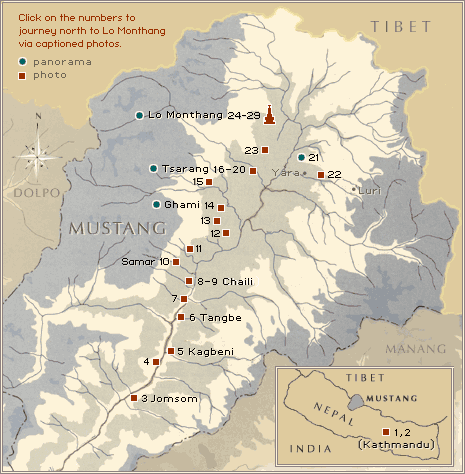While Mustang has been inhabited for millennia, and lies on a major North-South trade route used for centuries, very few Europeans had ventured into the Kingdom prior to 1992. The first recorded visit was by Swiss explorer and geographer Toni Hagen, in 1952. British Tibetologist David Snellgrove visited and researched Mustang’s Buddhist temples and monasteries in 1956, 1960–61. And in 1964, a young French anthropologist, Marcel Peissel, undertook an extensive stay to study the land, its people and its customs. His book, Mustang: The Forbidden Kingdom (1967) is a supple, humorous, sensitive and thorough picture of the Kingdom in the mid-20th century. Much of what I’ve learned about Mustang’s recent history and customs comes from him.
So, it has only been within my lifetime that Mustangis have had any interaction with the “West”. It seems like a land that time, or at least the modern world, forgot. It is quite small, maybe 40 miles from Kagbeni in the south to the Chinese border in the north. All the land is higher than my home in Snowmass, Colorado, 8300’.
The population, which probably numbers under 20,000, is confined to the lower valleys and hillsides, between 8600 and 13,000’ – the altitude of the ski area across the valley from my home. They live in an area about the size of Olympic National Park, on land that is just as rugged. But, unlike the Olympic rain forests, it is nearly devoid of vegetation. They survive by herding goats and dzo – a yak/cattle cross breed – into the high country during summer, tending irrigated wheat and barley fields in the spring and fall, and hunkering down during the snowy winters.
In 1959, China, which had only fitfully asserted its authority over Tibet following the fall of the last emperor in 1912, launched a full-scale invasion of the high plateau. The Dalai Lama fled over the mountains to exile in India. Local Khampa warriors continued a rear guard guerrilla fight from the mountain fastness of Mustang into the early 70s, when Chinese pressure on the Nepali, along with loss of CIA support coinciding with Nixon’s opening to China, ended the simmering conflict. That political unrest, coupled with the lack of roads, electricity, and any infrastructure for visitor services, along with the semi-independent governance by the local royal family, kept tourists away until 1992. By then, the Nepalese government had become a parliamentary democracy, and opened up the region. Permits ($500 apiece) were issued for entry, about 1,000 per year at the start. By 2014, that number had risen to nearly 3000. The major earthquake in Nepal the next year, although leaving the Mustang region untouched, nonetheless kept visitors to under 1,000 last year.
Change is constant, and life’s success depends on adaptation. Mustang has seen little change since the 14th century, but the last few years have brought increasing contact from the West, India, and China. Roads (an unpaved gravel track), electricity, and tourists spread across the former Forbidden Kingdom. But the high, dry, chilly climate, and the corrugated, incessant undulating landscape are still the primary determinants of life.
Our trip will start in Seattle. The next 24 hours, flying Emirates to Dubai, then on to Kathmandu. Two nights there, then fly to the lowland town of Pokhara. Although the next flight, to Jomsom, is less than an hour, it must be undertaken in the early morning. The route bisects the Himalayan gap between Annapurna and Dhaulguri – only a few miles wide, the mountains rising 16,000 feet above the 9,000 foot valley floor, through which fierce winds pour every afternoon as the southern flank heats up, warming the air and forcing it northward and upward to the Tibetan plateau. These five days will take us to the other side of the planet, in many ways exactly the opposite of our accustomed environment. From sea level to the roof of the world; from lush rain forest budding into a full-blossomed spring to a dry and dusty mountain desert.
From Jomsom, we’ll walk in the afternoon to the southern boundary of Mustang, where the sign “Restricted Area” ushers us into a place struggling to leap 6 centuries in just a couple of decades. Four more days of 6-8 hours of walking will bring us to the walled capital city, Lo Manthang. Three nights there, then return to Jomsom the long way round.
Deciding what to pack for this adventure has taken weeks. We are limited to 15 kilograms on the airplane into Jomsom, so every item must have a real purpose. I’m worried about several challenges. First, the weather. While it should be sunny most of the time, the temperatures will probably not exceed 55 or 60F, dropping a bit below freezing at night. And, my need for calories. Walking up and down 10 miles a day at 300-4000 meters threatens to sap my meager reserves. So I’ll be bringing secret sources of sustenence: powders and bars familiar to endurance activity.
(To Be Concluded: My Packing and Reading List)

